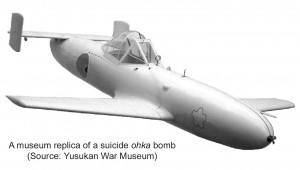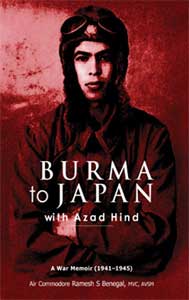The island of Iwo Jima had fallen into the hands of the Americans earlier, but Okinawa, the well-defended bastion, held out against the might of the US Navy and the bombing by the US Air Force. The Americans were however making headway and through their newly acquired air base at Iwo Jima, they were now deploying fighter aircraft to not only escort the B-29 bombers but to carry out strikes on targets in Okinawa and the Kyushu islands.
The Kamikaze
To counteract the rapid American advance, a large number of volunteers came forward to join the Kamikaze squad. ‘Kamikaze’ literally translates ‘God-wind’ or ‘the wind sent by God’. The expression and the practice belonged to earlier times, but became famous during the Russia–Japanese War in 1904–05. At one point, the Russian fleet was closing in and was heading for the shores of Japan. We were told that the Japanese had lined up on the shores with spears and bamboo staves in a last-ditch effort to defend the country from intruders, when all of a sudden, a typhoon of very high intensity materialised and wrecked the relatively flimsy craft of the invading Russian fleet, thus saving Japan and ensuring their ultimate victory in the war.
 The kamikaze pilots were all voluntary, ready to give up their lives to save their country from defeat. The modus operandi was for them to fly their bomb-laden aircraft directly onto the enemy ships and voluntarily lose their lives in the attack. Later this process was modified with the ‘baka’ bomb. ‘Baka’ literally means ‘fool’ and to this day, the rejuvenated Japanese defence air force personnel do not approve of the word being used to describe what is still considered one of the glorious chapters of their air force history. They preferred the word ‘ohka’.
The kamikaze pilots were all voluntary, ready to give up their lives to save their country from defeat. The modus operandi was for them to fly their bomb-laden aircraft directly onto the enemy ships and voluntarily lose their lives in the attack. Later this process was modified with the ‘baka’ bomb. ‘Baka’ literally means ‘fool’ and to this day, the rejuvenated Japanese defence air force personnel do not approve of the word being used to describe what is still considered one of the glorious chapters of their air force history. They preferred the word ‘ohka’.
The ohka was a short-range rocket-assisted aircraft carrying more than a ton of explosives in its nose. The pilot’s controls consisted of only a joystick for elevator and aileron movement and a pair of pedals to operate the rudder and nothing else, not a single instrument. This aircraft was slung under its mother aircraft, a medium bomber, and then directed in a rocket-assisted dive onto the target, by its suicide pilot. The manoeuvre was thought of because of the colossal losses in aircraft when other methods were used. It is now believed that the use of this kamikaze baka bomb might have been more effective if they had heeded the advice of the Japanese technicians who had recommended that a more powerful war-head be used.
The kamikaze pilots were all voluntary, ready to give up their lives to save their country from defeat. The modus operandi was for them to fly their bomb-laden aircraft directly onto the enemy ships and voluntarily lose their lives in the attack.
Despite this drawback, the kamikaze attacks did extensive damage to the US fleet, and warships of all categories were damaged, including aircraft carriers. Some battleships and destroyers were even sunk. Naturally, this kind of sacrifice by young trained pilots, could not go on forever. One has to admire the selfless courage of these young men who consciously and willingly went to their deaths for their country.
One of the unique methods the American Navy employed in trying to evade these kamikaze attacks was setting up a barrage of water-spray operations with powerful pumps and hoses all around the store ship, thus making it difficult for the kamikaze pilot to aim at any vital part when he came in for the final suicide dive.
Those who volunteered to be in the kamikaze squad were treated like heroes. They wore a distinguishing headband imprinted with the rising sun, a sign which marked them out from the others. A few of them lived in the Academy, and I had long conversations with them. They all seemed very certain about their choice of role, and did not show any sign of fear or regret. We regarded them with awe.
A few days prior to their being detailed for the sortie that was to be their final one, they were allowed to have whatever they wanted. Then, for two days, they were segregated from other groups and allowed to meet only their family and close friends. On the final day, they were briefed, said their prayers and took off on the one-way mission.
 A mock transport aircraft plane had been assembled near our gliding hangar, and the area was cordoned off. Because of the trees surrounding the area, we could not hear the noise of dummy-rounds being fired and the shouts of ‘Banzai’ (victory). It was much later that we came to know what it was all about. It was a session that only the Japanese in their desperate position could have thought of. A plane carrying highly trained commandos was actually attempting to land on the American Okinawa air base in a lightning suicide attack, trying to destroy as many aircraft as it could on the ground. It is true that years later, Israel did the same at Entebbe, but that was not a world war or a war against a powerful enemy, or at such a well-defended base.
A mock transport aircraft plane had been assembled near our gliding hangar, and the area was cordoned off. Because of the trees surrounding the area, we could not hear the noise of dummy-rounds being fired and the shouts of ‘Banzai’ (victory). It was much later that we came to know what it was all about. It was a session that only the Japanese in their desperate position could have thought of. A plane carrying highly trained commandos was actually attempting to land on the American Okinawa air base in a lightning suicide attack, trying to destroy as many aircraft as it could on the ground. It is true that years later, Israel did the same at Entebbe, but that was not a world war or a war against a powerful enemy, or at such a well-defended base.




